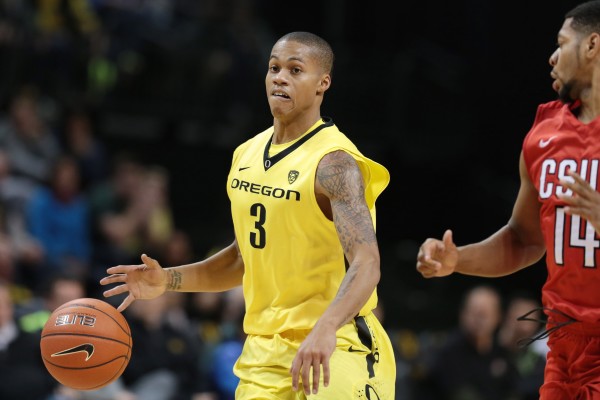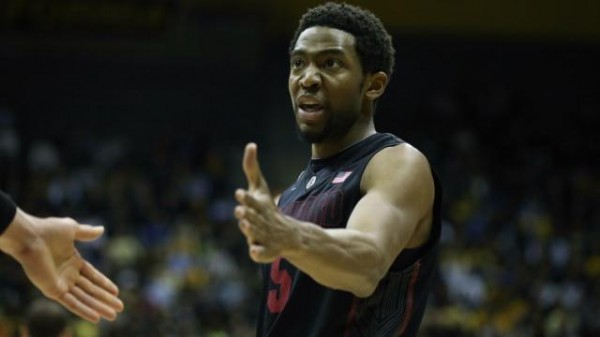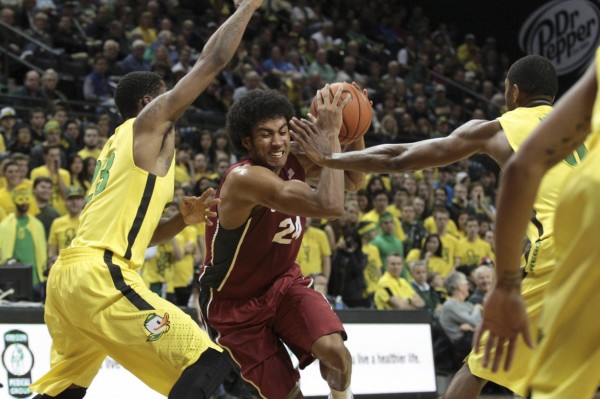Pac-12 One-on-One: Chasson Randle vs. Joseph Young
Posted by Andrew Murawa on January 2nd, 2015With data heavily reliant on KenPom.com and Hoop-math.com, along with contributions from Adam Butler, Kevin Danna, Connor Pelton and Tracy McDannald.
Regularly here at the RTC microsite, I’ll send out questions or polls to my group of trusted Pac-12 experts: Adam Butler, Connor Pelton, Kevin Danna and Tracy McDannald. We’ll gather votes to come up with consensus all-conference teams. We’ll ask who is the best defender, best dunker, best shooter in the Pac. And every now and then, we have some disagreements. This year, Oregon’s Joseph Young is perhaps our biggest source of regular disagreement. For instance, at the start of the season, I voted Young as the second-best player in the conference, behind only Delon Wright. None of my other trusted advisors ranked him any higher than sixth. We voted for best shooter in the league and I dialed up Young (and his 88.1% FT, 52.8% 2FG, and 41.5% 3FG) as the best in the conference; nobody else ranked him higher than third. And then, when we picked our mid-season all-conference team this week, I put Young in my top five, while only one other voter – Pelton – ranked him among his first five.
Now, all of this preamble of is not to lead into a 2,000-word post on why I’m right and everyone else is wrong, but it did allow me to dig into the numbers and compare Young to some of the other guards in the league. I looked at Washington’s Nigel Williams-Goss, I looked at Utah’s Delon Wright. And then I looked at Stanford’s Chasson Randle. And what I found was awesome. Below are screenshots from KenPom.com, detailing Young and Randle’s numbers as of New Year’s Eve.
The basketball nerd in me loved taking screenshots of those two stat lines and comparing them. Look at how similar they are, almost right across the board, starting with height, weight, class and continuing on. Their minutes, offensive ratings and usage numbers are almost all exactly the same. I shared these screenshots with the group, and the idea for a new post comparing similar players to each other was born. I remember some baseball magazine I used to read when I was a kid, back when I still thought baseball was interesting. One of their regular features was to compare and contrast players with some similarity: Alan Trammell vs. Ozzie Smith; Tony Gwynn vs. Wade Boggs; George Brett vs. Mike Schmidt. I loved those things, even if for the life of me I can’t remember the name of the magazine or the name of the feature. (Oh, by the way, the fact that guys like Trammell, Lou Whitaker and Jack Morris are not in the baseball Hall of Fame is ridiculous, says this guy, who hasn’t watched more than nine innings of baseball in a season since before the MLB cancelled the 1994 World Series). I figured we’d try a similar thing here. Sure, baseball is more of an individual sport made up of clearer one-on-one match-ups – pitcher vs. hitter and whatnot. And just looking at the numbers for any individual basketball player without taking into account team composition and even the variability of a schedule is a fool’s errand, but I’ve never been scared of looking foolish. I’m not always going to try to establish exactly which player is better, but I’m going to try to lay out all the facts you’ll need to come up with your own opinion. Here is the first edition of RTC Pac-12 One-on-One.
Let’s refer back to those KenPom numbers, which started me down this particular rabbit hole. Randle’s got a smidge more steals. Young’s advanced shooting numbers are a bit better and his rebounding numbers are better (Young is a good rebounder, but we can explain away the players’ difference in rebounding by looking at the height across Stanford’s front line compared to the lack of it on Oregon; in other words, Young rebounds at a slightly elevated rate because he has to). But three things stand out from Young’s perspective here: first, how the hell is Young “only” shooting 33 percent from deep? Prior to this season, Young’s lowest annual three-point percentage was 38.2 percent as a freshman at Houston. However, as the team’s go-to scorer this season, he’s found himself taking some questionable shots — he’s logged 14 this season with five seconds or fewer on the shot clock, only two of which were made threes. Still, given that Young’s teammates are gaining experience and look very capable of helping out offensively, you can probably take all of these data points together and come to the conclusion that Young’s three-point percentage should progress toward the mean over the course of the Pac-12 season, a scary thought for Oregon’s opponents. Look for a Young hot streak coming to a Pac-12 arena near you in the not-too-distant future.
The second point that jumps out to me is the fact that Young is assisting on 23 percent of his teammates’ made field goals compared to Randle’s 16 percent number, this despite the fact that Young is pretty clearly a two-guard and Randle is ostensibly a point. Now, neither of those things is cut-and-dried. In this era of basketball, positions are largely irrelevant, but while Randle is the one who often brings the ball up and initiates offense for Stanford, that is rarely the case for Young at Oregon. Still, Young is Oregon’s best playmaker. He’s got a tight handle, a quick first step and good vision. The fact that he has the well-earned reputation as a deadly shooter causes defenders to play too far up on him, allowing him to use his excellent quickness to drive and draw defenders, opening up more space for his young teammates. Randle, on the other hand, is just not cut from the same cloth. He’s being pressed into point guard duties, but really, he’s a scoring point. He wants to get his own. There’s nothing wrong with that notion, especially since it goes a long way towards helping his team to win. But nothing about Randle’s assist rate this season is aberrational at all. As Kevin Danna put it, he’s an “I’ma-get-you-this-bucket-when-we-need-it-most” kind of guy. But, for my money, Young has both qualities. Young can get his own, or he can drive, draw and dish, although he’s admittedly better at the former than the latter. Randle, on the other hand, is a bit more one-dimensional in this area.
The last thing that jumped out to me about those KenPom numbers was that, contrary to the image of Young as “just a bomber” who jacks up threes with abandon (and admittedly, he’s taking 54.9 percent of his field goal attempts from behind the arc), he’s actually a really good finisher inside, as evidenced by that 53.7% two-point conversion rate. To dig deeper, we need to pull in some data from the other indispensible college basketball statistics site – Hoop-math.com. Their season numbers for Young are a bit different, since they include Young’s 10-of-18 night against non-Division I Concordia (which KenPom does not include), but they have Young taking 47.5 percent of his shots from inside the three-point line and 24 percent of his shots coming at the rim. Of his 48 attempts at the rim, Young has made 68.8 percent of those. It’s also interesting to note that his attempts at the rim are actually down significantly this season. Last year he took 35.2 percent of his attempts at the rim and converted on 60 percent of those. This means that his two-point percentage has actually improved this season despite taking a higher percentage of those attempts farther away from the hoop.
Here’s where we’re going to start to make the transition from talking primarily about Young’s game to talking about Randle’s. While the Stanford senior is only making 51.6 percent of his shots, there is a subtle difference. Of Young’s shots at the rim, he was assisted on nearly half of them, meaning he’s getting those close shots as a result of cuts. He’s still converting them, of course, but it is not like he is only getting those shots by beating his man straight up off the bounce and getting to the tin. Randle, on the other hand, was assisted on just 31.2 percent of his shots at the rim. Part of this discrepancy is surely due to the two team’s offensive styles (Stanford runs more NBA-style isolation, while Oregon has more involved sets), but let’s get right to the point: While Randle and Young are both very capable off the bounce, Randle is the guy you want to bet on to beat his man off the dribble.
And really, what Randle is doing on that front this season has been a little disappointing. Last year seemed to mark a turning point for his game. In his first two seasons, he took 47 percent of his field goal attempts from deep; but last year – by far his most successful campaign – that number dipped to 38 percent. It’s no wonder that he set career highs for the number of fouls he drew per minute and the rate at which he went to the free throw line last year.But this year, however, he’s reverted back to the bomber role, taking 45.5 percent of his attempts from deep, many of them bad threes. All of which conspires to mean that his three-point percentage is down, his two-point percentage is down, and the rate at which he gets to the line is significantly down. The worst aspect of that whole confluence of events is that Randle’s free throw percentage is by far the best in his career (93.8%); he’s only missed three shots from the line all season long (the same number as Young). If Randle had been getting to the line at the same rate and converting at that percentage, he would have accrued 26 additional points for his team over the course of the season, better than two points per game. For what it’s worth, Stanford lost by two at BYU in a game where Randle attempted seven three-pointers and only three free throws.
The last area for comparison is the most difficult, since we don’t have a lot of meaningful individual numbers to draw from. But the defensive edge goes slightly to Randle. Young is a capable defender with quick hands, known to jump in a passing lane and earn a breakaway layup every couple of games, but in order to produce those opportunities, he tends to cheat a little. Randle, on the other hand, is a no-nonsense, gritty, mano-a-mano defender, equally adept at squaring up against an off-the-dribble threat or chasing a little guy off multiple screens. He plays bigger and stronger than his size and, on a team with a lot of defensive deficiencies, is about the lone individual bright spot (aside from freshman Robert Cartwright, who is going to be a defensive terror until 2018). Both are vocal floor generals on the defensive end and neither is a defensive liability, but Randle just has more tenacity and focus in this area.
Now here’s another significant thing to consider. Oregon has so far played six teams ranked in the KenPom top 100 (an admittedly arbitrary cut-off), whereas Stanford has played just four. But Stanford – with a 1-1 record against Duke and Texas, two teams in the KenPom top 11 – has played higher-end competition. Considering that both of these teams have played their fair share of glorified scrimmages as well, things are going to change as the level of competition ticks up considerably. As we said above, we’ll probably see Young’s three-point percentage noticeably increase. Randle probably isn’t going to continue shooting so well from the line. Neither player will spend as much time bombing from deep. But in the long run, just referring back to those first few signifiers on the KenPom sta -line – 6’2”, 185 lbs, Sr – these are two players who have plenty of similarities.
If you had to pick one over the other, it could understandably come down to the specific make-up of the guys you’ve got surrounding them, but the fact is that you can’t go wrong with either of these players: both veteran, highly efficient, numerically similar dead-eyes who are a heck of a lot of fun to watch. For my money, I’d take Young over Randle by the ever-slimmest of margins, with my opinion set to vacillate on a bi-weekly basis throughout the winter and into the spring. But most of all, I’m plenty happy to enjoy 18 more Pac-12 games out of each of them.
Just one more thing, apropos of nothing really other than one final small data point. Joseph Young and Chasson Randle have met each other on the college basketball court exactly one time. Final: Stanford 82, Oregon 80. Randle’s contributed 23 points on 14 field goal attempts, with six boards, four assists and one turnover; Joseph Young tallied five points on just seven field goal attempts, with five boards, two assists and one turnover. I would go further on that point, but that requires another 2,000 words on the different things Stanford did as a team to limit Young’s looks. For what it is worth, Stanford and Oregon play only once this season (damn you, 12-team leagues), on Sunday, March 1, at Maples Pavilion. Set your DVRs.














































